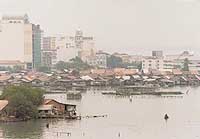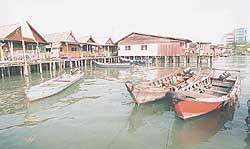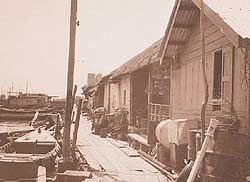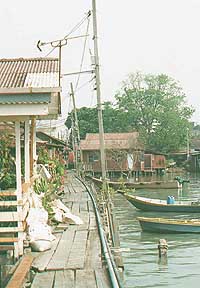
Historical backyard of Penang
(Taken from "The Star Paper, May 28 1988)
Rich in history and tradition, Penang's Weld Quay is a study in contrasts. The 2,000 wooden stilt houses on the seafront -- built by Chinese immigrants more than a century ago -- still lack proper sanitation but their interior boasts of modern furnishings, appliances and access to satellite TV. Ng Su-Ann and Ng Beng Thai visit the various clans occupying these settlements, which have survived the bombings during the Japanese Occupation and Penang's fast-paced development.

Floating city of Weld Quay
By Ng Su-Ann and Ng Beng Thai
BACK in the 1860s, young men from the Tong Aun district in China's Fujian province braved the high seas to come to Penang, in search of greener pastures.
They left their motherland in droves as the Manchu rulers of China lost their grip on power, and widespread poverty, famine and hardship became the order of the day.

Given its strategic location as a port of call and its comparative security under British rule, Penang was a natural choice for these Tong Aun migrants who flocked to the island.
Housed in crowded shacks by the sea, initially they worked as coolies, but as time went by many became self-employed as ferry operators, transporting people and goods between anchored ships and the harbour.
The hard work, thrift and perseverance of these migrant workers eventually paid off when they were able to bring their families over from China.
Over the years, clusters of jetty settlements multiplied along Weld Quay, the rows of wooden stilt houses spreading seaward as more and more families joined the pioneers.
The settlements were divided into four distinct kongsi groupings, according to clan — namely the Tan Jetty, Lim Jetty, Chew Jetty and Yeoh Jetty.
Today, over a century later, the Weld Quay area looks much the same — untouched by the development that has taken place all around. Homes and sundry shops-on-stilts flourish, while Indah Water sewerage bills are unheard of here.
A few changes, though, have taken place. For one, the residents now no longer depend on the sea for a living; many of them work on land, as hawkers, factory hands, shopowners and clerks.
The residents too have seen a decrease in vessels docking at the harbour since the 80s. Compared with the days of old when hundreds of vessels docked at the jetties, an average of only about 50 ferries are seen these days.
The early years
"Like the others, my ancestors came from China in the year 1918 when they heard that jobs were aplenty here," says Tan Bee Eng, headman at the Tan Jetty.
"When my father heard them rave about Penang being a land of abundance, he was here in no time to earn a living. He eventually worked as a ferry operator," Tan recalls.
Based on stories passed down the generations, the jetty settlements grew from the burgeoning stilts to which the ferry boats were tied.
"As the number of foreign ships which anchored at the harbour increased, so did the stilts. Initially, planks were placed on the stilts to enable passengers to disembark without getting wet. Later on, the planks were joined together to construct a jetty."
In the 40s, the clans did not escape the hardship under the Japanese Occupation (1942 to 1945). According to a journal kept by the Penang Tong Aun Kim Har Association, an attap hut caught fire in the bombings but the settlers managed to put it out before it could spread.

During those years, all marine activities, including ferrying and fishing, were restricted and the settlers were forced to buy stale, rotting fish in the market. This prompted some of them to saw a hole in their huts' timber floors for clandestine midnight fishing.
When the British resumed government of Malaya, the clansmen's lives returned to normal. In 1954, two basic utilities — water supply and electricity — were installed for them.
Those days, dragon boat races were held among the clans on the fifth day of the fifth month of the Chinese lunar calendar. The gaily-decorated boats bearing the banners of the various clans, were a sight to behold as the clans battled for honours. However, jealousy and envy soon ravaged sportsmanship among the clans, leading to the eventual transfer of the organising of the races to the State Government.
Framed photos of the first dragon boat race can be seen in the office of the settlement's oldest resident, 88-year-old Chew Boon Pee, whose proudest moment was when he received the champion trophy on behalf of his team from Malaysia's first Yang di-Pertuan Agong.
Following in his father's footsteps since the age of 15, Chew was a ferry boat operator for about 35 years before opening his own oil trading company in Weld Quay.
"During my childhood days, I often went skinny-dipping in the sea as there was no public swimming pool then," he says.
The Chew Jetty settlement is the biggest of the lot, having grown from about 10 families back in the 20s to over 1,500 residents today.
Last year, Weld Quay residents learnt with relief that their settlements would not be affected by the RM300mil Jelutong Expressway project.
New settlements
In the early 60s, the Weld Quay settlements were joined by the Sin Keo (in Hokkien, "new jetty") which was home to a mixed group of clans.
These were people who had built illegal houses in the Tan, Chew and Lim clan jetties and were evicted by the State Government. They later obtained approval from the authorities to build their own jetty.
In 1962, in line with plans to build a harbour at Light Street, the Lee clan was also relocated to the new jetty in Weld Quay.
Among its pioneer clansmen was 72-year-old Lee Hock Se, who recently passed away. Lee had journeyed from China to Penang in 1948.
"Life in China was hard and most of us had to struggle through poverty and hardship," he wrote in a journal.
Upon arriving in Penang, he joined other ferry operators from the Lee clan to earn a living.
There was fierce competition between clans to woo passengers and this often led to bloodshed. As the Lees had the most number of sampans, the other clans envied their advantage and ganged up against them.
Eventually, the clans reached a compromise; the Lees would ferry people from the ships to the island, while the others could bring the people to the ships.
Cultural hub
Dubbed Penang's historical backyard, the jetties are frequented by tourists and locals. While some are brought to the area by tour guides, others come in their own sailboats.
Every Thursday, a Singapore cruise ship brings a convoy of tourists to view the heritage jetties with their quaint wooden stilt houses.
Dutch tourist Helga Hesse likens the Weld Quay jetty to a "floating city" where simplicity and serenity prevail. "The jetty, with its clan settlements, is probably the only one of its kind in the world," she says.
Yearly, the Weld Quay settlements take on a carnival atmosphere when they celebrate the birthday of the Kew Ong Yah (Nine Emperor Gods).
Thousands of devotees and tourists would turn up to give a rousing send-off to the float that carries images of the deities. At the waterfront, the sacred float is lowered onto a fishing boat accompanied by temple officials carrying an urn. As the fishing boat leaves the shore, devotees would clasp their hands in prayer.
Says temple spokesman Lim Cheng Thor: "We will go quite far out to sea until the lights from the shore are mere flickers. We then seek the spirits' advice on the most favourable location to set adrift the float. We normally do this by using the divine blocks (two kidney-shape pieces of wood)."

In another annual religious festival, the Chew clan worships the Jade Emperor on the eve of the ninth day of the Chinese New Year in grandeur and style.
Here, a 50m-long food-laden altar takes centrestage. Piled high on adjoining tables is a sumptuous array of delectables — including roast pig, chicken, duck, fruits, red tortoise buns (mi ku in Hokkien), miniature rock sugar pagodas and rice wine.
A little after midnight, instead of the usual burst of firecrackers, the rousing beats of 15 Chinese drums would roll as two prancing "lions" take to the streets.
With its interesting blend of cultural and religious activities, life at the Weld Quay settlements is never dull.